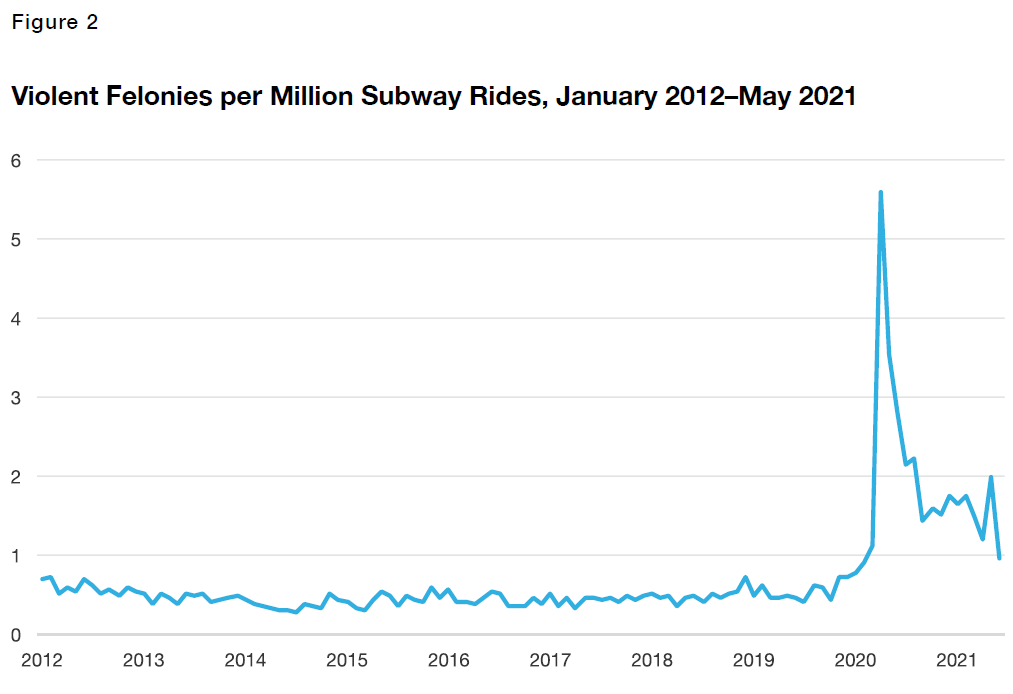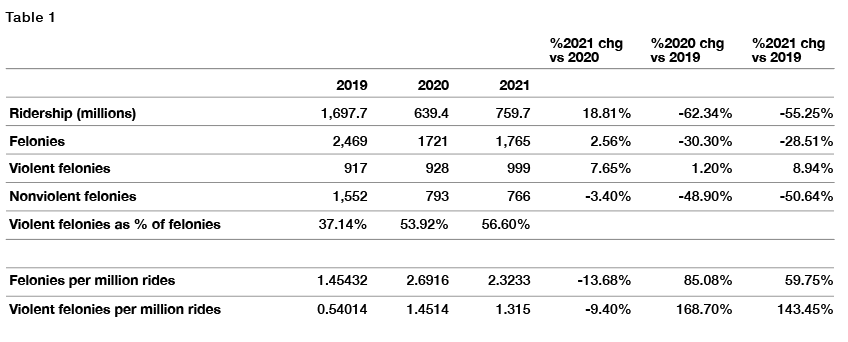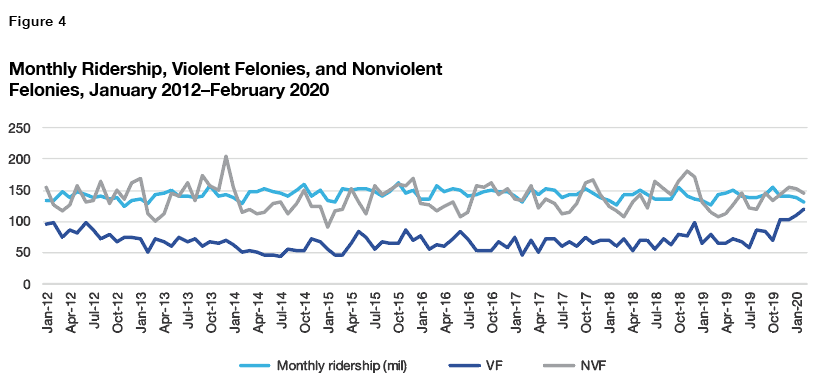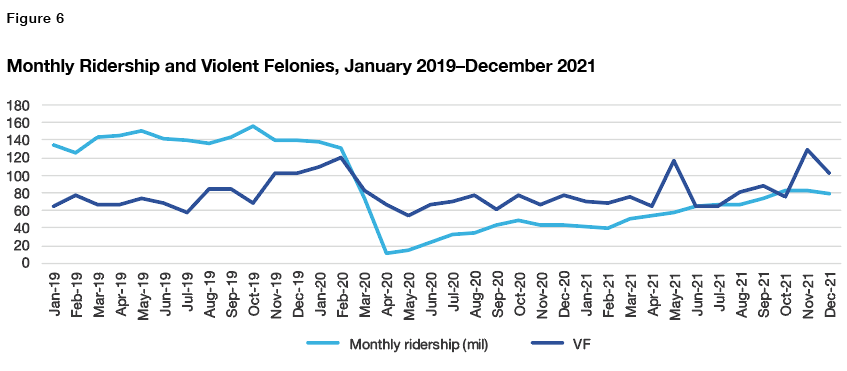Public Safety on NYC Subways: No Safety in Small Numbers

During Mayor Eric Adams’s first seven weeks in office, soaring violent crime in New York City’s subway system dominated the local news. Public fear and frustration peaked in mid-January, with the murder of 40-year-old Michelle Go, who was shoved from a Times Square subway platform onto the tracks in the middle of the day. Go’s alleged killer, an apparently mentally ill and homeless man who had repeatedly violated parole for a 2017 violent felony conviction, was yet another example of the city and state’s failure to treat and supervise violent mentally ill people, or to incarcerate violent offenders.[1]
Go’s death was a tragic instance of a now nearly two-year-old phenomenon. When subway ridership fell precipitously in March 2020, to as low as 6.5% of the pre-Covid normal level of 5.6 million riders each weekday,[2] violent felonies did not fall with passenger numbers. Violent felonies rose sharply, not only on a per-rider basis but in absolute numbers. A beneficial “safety in numbers” effect, supplemented by the legacy of decades of proactive policing, had disappeared.
Now the full data for 2021 are in, and a new, longer-term trend persistent through the second year of Covid has become clear. As ridership has gradually returned, to an average of 59% of normal from early November until Christmas Eve 2021, violent crime has not gradually declined in tandem. Violent crime, both per passenger and, in some categories, in raw numbers, has remained persistently higher than it was in 2019.
Where there was safety in numbers before Covid and grave peril in desolation beginning in March 2020, there now exists an unhappy medium. Modest-size crowds—though larger than those in 2020—are not by themselves helping to deter violent crime. This stagnation of both crowd size and public safety is unlikely to fix itself: as people fear taking trains because of violent crime, they keep crowd levels low, thus enabling violent crime to persist at elevated levels.
At the same time, the NYPD and prosecutors have not stepped in to fill the vacuum. Preventive policing, in terms of arrests and civil summonses for alleged low-level law violations, remains far below pre-Covid levels.
In January 2022, before Go’s murder, new Mayor Eric Adams and Governor Kathy Hochul announced a joint state-city plan to secure the subways. (The city-run NYPD is generally responsible for public safety in the subways, not the state-run Metropolitan Transportation Authority, which runs the trains.) As of mid-March 2022, however, the plan has not yet achieved results: for the year through March 13, transit crime was up 80.3% compared with the same period in 2021.[3] To restore order on the subways, the city must go beyond the improved mental- health treatment that the plan promises. Rather, police have to return to proactive and preventive policing and deterrence—and prosecutors need to follow through on these cases. In 2019, New York City and tristate residents depended on mass transit for three-fourths of their daily commutes into Manhattan. Without safe transit, Manhattan and the city cannot recover economically from Covid.[4]
Recap of 2020: Low Ridership, High Violent Crime
As the Manhattan Institute reported last summer,[5] the subways were a violence-reduction success story from the early 1990s until 2019. Proactive policing, begun in the 1990s by then–transit police chief William J. Bratton, cut felonies by 15% just in 1991, and felonies underground continued to decline to record-low numbers.[6] While enforcing rules against fare theft and loitering, police found contraband guns and knives on low-level offenders, and they also pushed antisocial and disturbed individuals out of the transit system.
As subway ridership rose to record-high levels by 2015, larger crowds created “safety in numbers,” a virtuous circle that allowed police and prosecutors to pull back on criminal enforcement in the decade leading up to 2019, relying more on civil summonses, without seeing a commensurate rise in crime, something that Bratton called a “peace dividend.”[7] (Fare evaders, for example, are subject either to misdemeanor arrest for “theft of services” or to a $100 civil summons.)
This shift in enforcement practices—from criminal to civil sanctions—was the result not only of a safer subway system but of changes in political philosophy of elected officials, particularly prosecutors. Former Manhattan district attorney Cy Vance, for example, said that he would stop prosecuting farebeating suspects in 2017,[8] a policy that his successor, Alvin Bragg, who took office in January 2022, will continue. In 2018, partly in response to Vance’s announcement, the NYPD implemented a policy that reserved citywide arrests for farebeating only for people who had outstanding warrants, were on parole or probation, or fit other narrow categories; other offenders would receive the civil summons (see Figure 1).[9]
Indeed, there are signs that the “peace dividend” began to fray in the months before Covid-19; it was then utterly broken by the abrupt decline in subway ridership beginning in March 2020. Lower passenger numbers did not result in a commensurate per-capita decline in subway felonies. For the year as a whole, the rate of felonies per million rides nearly doubled, from 1.45 in 2019 to 2.71 in 2020.
During that first Covid year, the types of felonies committed on the subways also changed for the worse. Before the pandemic, grand larceny—the major nonviolent felony (along with the much rarer crime burglary, usually of poorly secured MTA property)—was the most common on the subway. In 2020, grand larcenies fell, along with ridership.
By contrast, violent felonies—murders, rapes, robberies, and assaults—rose, not just per capita but also in raw numbers. The number of murders in 2020 rose to seven, from an average of 1.43 per year between 1997 and 2019.[11] Robberies increased by 3.8%. Though assaults declined by 4.9%, violent felonies overall increased by 1.1% over the year.
Coupled with the severe and sustained drop in ridership—as low as 6.55% of normal in April 2020, and just 31.2% of normal by November and December 2020—these increases in violent crime put each passenger at far greater per-capita risk of an instance of bodily threat (robbery) or harm (assault, rape, or murder).
Though the per-rider risk of violent felonies abated throughout the second half of 2020, from the extreme high of 5.59 per million rides in April of that year, it remained elevated (Figure 2). During the final six months of 2020, for example, compared with the final six months of 2019, there were 1.78 violent felonies per million rides, three times the 0.59 per-million-ride average in the final six months of 2019.
A Recap of Last Year’s Research
2021: Ridership Was Higher, but So Was Violent Crime
The good news for New York is that for most of 2021, until the Omicron variant curtailed day-to-day activities in the second half of December, subway ridership trended gradually upward, reaching 59.4% of normal by November.[12] The bad news is that this higher ridership did not deter violent subway crime. Many riders are returning to the subways, including to stations and trains that were previously the most crowded and safest, but not enough are not returning to re-create “safety in numbers.”
In other words, in March and April of 2020, violent crime abruptly rose as subway ridership abruptly declined. But the opposite is not occurring. Violent crime is not gradually declining as ridership gradually rises. Rather, violent crime is now increasing with ridership, keeping Covidera per-capita crime rates high.
As Table 1 shows, violent crime rose throughout 2021 just as ridership rose. From 2020 to 2021, subway ridership rose 19%. Yet violent felonies also rose, by 8%. The subway system thus made little progress in reducing the high 2020 violent felony rate of 1.45 per million rides; it fell only to 1.31, still nearly two and a half times as high as (143% higher than) 2019 levels.
2021: Ridership Was Higher, but So Was Violent Crime
Moreover, the 2020 trend toward violent felonies, as opposed to larcenies, persisted throughout 2021. Violent felonies soared from 37% of felonies in 2019 to 54% in 2020; they have since risen even further, to 57% in 2021 (Figure 3).
Pre-Covid: As Ridership Stayed High, Violent and Nonviolent Crimes Both Remained Low
Before Covid, high ridership—“safety in numbers”—helped keep both nonviolent and violent felonies low. Both ridership and transit crime remained remarkably consistent from month to month. To the extent that ridership did make an almost imperceptibly small difference in crime numbers during the immediate pre-Covid years, higher ridership in a particular month slightly nudged nonviolent felonies (larcenies) up in that particular month and slightly nudged violent felonies down (Figure 4; see Appendix 2 for month-to-month statistical correlations).
Intuition bolsters these statistics. Larceny, the theft of property without violence or threat of violence, is not a “safety in numbers” crime. Rather, crowds create opportunities for larceny. When there are more people to nonviolently pickpocket, or when more people are around to accidentally leave their phones in the train, more such crimes will occur. As more people take the train, they collectively run a greater risk of having their belongings stolen. By definition, a victim does not notice a larceny when it takes place; otherwise, the victim would resist, and the crime would not be a nonviolent larceny but a violent robbery or assault. But violent crimes are “safety-in-numbers” crimes—that is, deterred by larger groups of people. A large crowd is likely to intervene in an attempted assault, or, at the very least, catch the perpetrator afterward.
Even before Covid-19 hit New York in March 2020, early signs emerged that crowds alone could not compensate for the significant pullback in policing and prosecution. Between November 2019 and February 2020, violent felonies in the subways increased by 36%, compared with the same period a year earlier (from 319 to 434), surpassing 100 each month for the first time since before 2012.
The Plague Years, So Far: Larcenies Continue Their Pre-Covid Pattern
During 2020 and 2021, nonviolent larcenies have continued their pre-Covid pattern: as ridership rises, larcenies rise, and vice versa. As more people return to the subway, more people run the risk of becoming victims of larcenies (Figure 5).
Violent crime, on the other hand, has diverged from the pre-Covid state of affairs (or, at least, the state of affairs that persisted until the fall of 2019). As riders have gradually returned since the spring of 2020, violent crime has not gradually decreased; rather, violent crime has continued to increase in absolute terms (Figure 6). In 2021, there were seven murders on the transit system, the same as the year before. There have been two subway murders in the first months of 2022, already eclipsing the number of annual murder victims in any year between 2009 and 2018. Assaults have also risen.
Just as with nonviolent felonies, the explanation follows the intuition. With ridership still at roughly 50%–60% of the pre-Covid normal, the subway system has not yet re-created the “safety in numbers” state that existed until late 2019. More people are riding the subway, but they have not yet achieved the critical mass to keep one another safe. Absent those critical numbers, each new rider becomes a new potential victim.
Thus, subway riders must depend on policing, more than ever before, to keep themselves safe. Yet after Covid-19 hit, police severely pulled back on arrests as well as summonses, and they have not returned to pre-Covid levels of enforcement (Figures 7 and 8).
Through the end of 2021, the violent crime rate in the subway had stabilized in a range at a much higher level than before Covid (Figure 9). The rate shows no sign of falling in tandem with continued gradual increases in ridership. The risk is that the critical mass will remain missing indefinitely.
Public Perception: Why Do People Care So Much About Subway Crime?
Despite the higher risk of becoming a victim of violent crime on the subways, the overall risk remains low. For example, consider the seven subway murders in each of 2020 and 2021. Weekday passenger levels averaged 2 million during 2020—thus, assuming that the same people ride the subways twice each weekday throughout the year, the risk of becoming a murder victim that year was 0.7 per 100,000 people, and slightly lower in 2021 as ridership rose. These figures are a small fraction of the city’s overall murder rate of 5.6 per 100,000 residents annually across these two years.[13]
Yet this out-of-context analysis ignores the psychological change in moving from virtually no risk to some risk. Before 2020, with an average of one or two murders a year on the subways for more than two decades, and with daily ridership nearly 6 million people, the risk of becoming a murder victim on the subway, again, assuming two-way trips (that is, approximately 3 million people daily) was truly minuscule: less than 0.05 per 100,000 people. The per-capita risk has thus increased 14-fold over a dizzying two years. By contrast, between 2019 and 2021, the murder rate citywide increased 53% across a stable population—a historic and disastrous increase, to be sure, but not the same as taking something virtually riskless and introducing a new and unpredictable element of risk.
Public concern over violent subway crime is also elevated because it is almost always stranger-on-stranger crime. In each of the 16 subway murders that have occurred since March 2020, evidence exists in only one case that the victim knew his perpetrator. By contrast, across the country, in homicide cases where a suspect has been identified, 80.6% of victims know their perpetrator, and there is no reason to think that New York City is any different.[14]
Fear of subway crime is thus a barometer of fear of random stranger-on-stranger crime citywide. Though the issue gets less attention, it is also a barometer of the danger that society’s most vulnerable individuals face: in at least five of the 16 subway murder cases since 2020, the victim was homeless (see Appendix 1).
Policing and Criminal Justice: Is It Working?
As Bratton demonstrated in the early 1990s, police stops for farebeating and other minor subway crimes are a good proxy for preventive-policing activities, as a disproportionate number of farebeaters go on to commit larger crimes in the transit system. This connection persists 30 years later. For example, the three suspects in the menacing death of Roland Hueston at the Fordham Road subway station on New Year’s Day 2022, the first subway murder of the year, were caught on video entering the subway through the exit gate.[15] Yet with farebeating arrests and summonses persistently down, police are not engaging in enough interactions with such low-level criminals before they go on to commit a larger crime in the subway system.
The Police Cannot Do It Alone: Mental Health and Prosecution
Policing cannot have a strong impact in a vacuum of mental-health and prosecution support. Martial Simon, the alleged killer of transit customer Michelle Go on January 15, has a long history of severe mental-health problems.[16] In at least one-quarter of the subway murders since 2020, and in nearly one-half of the subway murders in which a suspect has been publicly identified, the suspect appears to have suffered from well-documented mental illness before allegedly committing his subway homicide (see Appendix 1). In at least three of these cases, the suspect was free on charges stemming from an earlier alleged violent crime before committing his subway crime, indicating a failure of prosecutorial and criminal-justice supervision.
Prosecutors cannot ignore lower-level crimes, either. Allowing fare evaders constant access to the subway system with no practical repercussions encourages disorder and violent crime. Absent prosecution for chronic farebeating, there is no incentive for recidivist farebeaters to cease their behavior after receiving a civil summons. A 2016 state comptroller’s report found that half of civil summonses went unpaid.[17]
The Adams-Hochul Plan: Will It Work?
On January 6,[18] and again on February 18,[19] Mayor Eric Adams and Governor Kathy Hochul jointly announced and then reannounced their “subway safety plan.” The plan is almost entirely focused on homelessness and mental health rather than criminal and civil enforcement of laws and rules.
For example, the city, with state support, will deploy “up to 30” civilian homelessness and mental-health outreach teams across “high-need locations across our city,” including in the subway system, to approach people who appear to be in need of help. The city will also expand its pilot whereby civilian mental-health workers, rather than police officers, respond to nonviolent 911 mental-health calls. The city and state will create new “drop-in centers” near subway stations, so that mental-health workers can “directly transition” people from subway stations to “safe spaces.” Finally, the city and state will expand the number of in-patient psychiatric beds and “streamline” the placement process for supportive housing for the mentally ill.[20]
The only provisions of the plan that involve direct policing are “requiring—instead of requesting— everyone to leave the train and the station at the end of the line” and “training NYPD officers . . . to enforce the MTA and New York City Transit Authority’s rules of conduct in a fair and transparent way.”
Though the plan deserves a chance, New York State and City have both tried mental-health outreach initiatives before, with no discernible impact on subway vagrancy, as the subjects of such outreach can simply refuse aid and wave outreach workers along.
As of late March, Adams was encouraging his police force to engage in more preventative policing in general, and more policing of fare-beating specifically. Yet farebeating arrests and summonses in January 2022 were 26% below comparable figures in January 2019.
Moreover, Adams has not yet said clearly that all people loitering long-term in subway stations and on subway platforms, rather than using the transit system to get from one point to another, must leave the system, as opposed to just leaving at the end of the line.
New York is unlikely to reverse its underground-crime crisis without such proactive policing and mental-health treatment. Recidivist fare evaders who have not responded to civil summonses should face arrest, mental-health evaluation, and close supervision in lieu of incarceration. People who refuse mental-health services but who are breaking low-level laws must be compelled into treatment, if necessary, through the criminal-justice system’s diversion programs, as a point of entry. People who refuse mental-health services and are incompetent to make such decisions must be compelled into either outpatient or inpatient treatment, including, in the former instance, using the court system via Kendra’s Law.[21] Chronic farebeaters and other low-level subway violators judged mentally fit who do not respond to multiple incarceration- diversion programs must face a criminal-justice penalty in the last resort.
Economic Risk
Large percentages of subway customers consistently tell the MTA that fear of riding the subways is keeping them from resuming their pre-Covid day-to-day routine. In a fall 2021 MTA survey, for instance, 49% of current subway customers said that they take the train less often because they “don’t feel safe from crime and harassment on the subway.” Some 68% of “lapsed” customers—people who have largely refrained from using trains since Covid—said that fear of crime was preventing their return. Customers listed “fear of crime and harassment on trains” as their single biggest area that “needs improvement,” with “fear of crime and harassment in stations” as number four.[22] The numbers are far higher than the answers to similar questions asked in the fall of 2019, when 65%–70% of riders felt safe on trains and in stations.[23]
Absent assertive action on the part of civilian mental-health professionals as well as the criminal- justice system to secure the subway system, the city risks creating a long-term torpor both for the subways and for the NYC economy. Low subway foot traffic helps create the conditions for violent crime, and violent crime, in turn, helps perpetuate the low subway foot traffic. It’s possible, but hardly assured, that this situation will simply resolve itself absent an outside catalyst. In the meantime, Manhattan office buildings remain three-quarters empty as of late January 2022.[24]
Conclusion
As New Yorkers grapple with high rates of violent crime underground, city and state government cannot depend on riders gradually returning to the system to re-create the “safety in numbers” that predated Covid. Absent a critical mass of riders well above current levels, this equilibrium will not reoccur; moreover, violent crime was rising on the subways in the months immediately preceding Covid, despite the presence of large crowds. The city and state have presented a plan to address the situation; however, without clear, consistent enforcement of laws against fare evasion and other low-level crimes underground, including prosecution of chronic offenders who do not respond to civil action, the city and state will not be able to recreate order in the subway.
About the Author
Nicole Gelinas is a senior fellow at the Manhattan Institute, a contributing editor of City Journal, and a columnist at the New York Post. She writes on urban economics and finance. Gelinas is a CFA charterholder and the author of After the Fall: Saving Capitalism from Wall Street—and Washington (2011).
Gelinas has published analysis and opinion pieces in the New York Times, Wall Street Journal, Los Angeles Times, and other publications. Before coming to City Journal, she was a business journalist for Thomson Financial, where she covered the international syndicated-loan and private-debt markets. Gelinas holds a BA in English literature from Tulane University.
Appendix and endnotes
See appendix and endnotes in PDF
Are you interested in supporting the Manhattan Institute’s public-interest research and journalism? As a 501(c)(3) nonprofit, donations in support of MI and its scholars’ work are fully tax-deductible as provided by law (EIN #13-2912529).









